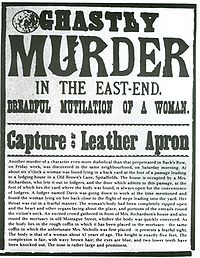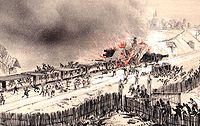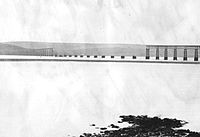- Cold case
-
For other uses, see Cold case (disambiguation).
Cold case refers to a scene of a crime or an accident that has not yet been solved to the full and is not the subject of a recent criminal investigation, but for which new information could emerge from new witness testimony, re-examined archives, retained material evidence, as well as fresh activities of the suspect (e.g. repeated deaths of wives of a suspect, who marries a lady and then does away with her for insurance gain). New technical methods developed after the case can be used on the surviving evidence to re-analyze the causes, often with conclusive results.
Contents
Characteristics of a criminal cold case
Violent or major crime
Typically, cold cases are violent or other major felony crimes, such as murder or rape which unlike unsolved minor crimes are generally not subject to a statute of limitations.
Sometimes disappearances can also be considered cold cases if the victim has been not seen or heard from for some time, such as the case of Natalee Holloway.
In about 35% of those cases are not really cold cases at all. Some cases become instantly cold when a seeming closed (solved) case is re-opened due to the discovery of new evidence pointing away from the original suspect(s). This happens in a surprising number of cases, and is the result of a miscarriage of justice. Other cases are cold when the crime, usually through discovery of human remains, is discovered well after the fact.[1] Other cases are classified cold cases when a case that had been originally ruled an accident or suicide is re-designated a murder when new evidence emerges.
The John Christie murders is a classic case, when Timothy Evans was wrongly executed for the alleged murders of his wife and child. Many other bodies were later found in the house where they lived with Christie, and he in turn was executed for those crimes. The case helped a campaign against capital punishment in Britain.
Identifying a suspect
A case is considered unsolved until a suspect has been identified, charged, and tried for the crime. A case that goes to trial and does not result in a conviction can also be kept on the books pending new evidence.
Often a case is not solved but forensic evidence helps to determine that the crimes are serial crimes. The BTK case and Original Night Stalker (still unsolved) cases are such examples.
Notable examples
- In 2005 Edmond Jay Marr pleaded guilty to 2nd degree murder to the March 1983 kidnap and murder of Elaine Graham, 29, a nurse and student at California State University at Northridge. He became a suspect when acquaintances noted that he was in the immediate area of her disappearance and was seen at a sister's home only a few blocks where the victim's car was found. Her skeletal remains were found by hikers in a wooded area halfway between where she was last seen alive and where the car was found some six months later. A knife found in the suspect's possession (when he was arrested for armed robbery a month later) was later proven to be the murder weapon when DNA evidence, unavailable in 1983, provided by Elaine's daughter matched blood found in the knife's crevices.[2]
- In 2002 Edward Freiburger was found guilty of 1st degree murder in the February 1961 murder of 60-year old John Orner, a cab driver in Columbia, South Carolina. Orner was robbed and murdered on the job with a .32 H&R pistol. Freiburger, then 19 and a soldier stationed at nearby Fort Jackson, became a suspect when it was discovered that he purchased such a pistol at a local pawnshop only hours before Orner received the dispatch call that would be his last. It was bolstered by the fact he went AWOL that night. He was picked up by Tennessee State Police a month later who found the gun in his possession. However ballistics tests were inconclusive and Freiburger was never charged. In 2002 a private firearms examiner working for the South Carolina Law Enforcement Division (or SLED) took the time to clean up the slugs and matched the bullets to the gun.[3]
- In 2003 John Henry Horton, 56, was arrested for the July 1974 murder of 13-year old Lizbeth Wilson in Prairie Village, Kansas. She had been last seen running across the field of the Shawnee Mission East High School by her brother John who was racing ahead of her about 7pm. Her remains were found in an empty field some six months later. Horton became a suspect when it became evident that she was last known to be alive at the school. He was the only known adult working on the school grounds that night. This was bolstered when other girls reported that he had tried to lure them into the school. Moreover the police found he took an extended break from 8:30pm until nearly midnight that night. They also searched his car and found a duffel bag and a bottle of chloroform. He explained it by saying he used the chloroform to "get high". However the evidence was circumstantial and he went free until 2002 when investigators interviewed a witness overlooked in 1974. She, then 15, had been given chloroform by Horton and while unconscious had been sexually molested by him. This led to his arrest and conviction in 2003. However, the story did not end there. The Kansas State Supreme Court in 2005 overturned the conviction on the basis that the "prior bad act" had not been placed on public record so the witness' testimony should not have been allowed. However they did grant leave to re-try and re-file the case. This time the evidence which was purely circumstantial, as well as the testimony of two of Horton's fellow inmates, was enough for a second jury to declare him guilty.[4]
- In 2003, Gerald Mason was arrested and charged with the murder of two El Segundo police officers, as well as rape and robbery, dating back to 1957.
- In 2011, 73-year old Samuel Evans plead guilty to 1968 & 1972 cold cases after DNA evidence linked him to the slayings.[5] The 1968 cold case solved by scientists at the Seattle Crime Lab is the oldest case ever solved using DNA Evidence.[6]
Tunnel vision
Sometimes a viable suspect has been overlooked or simply ignored due to then-flimsy circumstantial evidence, the presence of a likelier suspect (who is later proven to be innocent), or a tendency of investigators to zero in on someone else to the exclusion of other possibilities (which goes back to the likelier suspect angle) -- known as "tunnel vision":
- A notable example is the Peggy Hettrick murder case in Colorado.
- Another example is the Carol Hutto murder case in Florida. In December 1976 the 16-year old's body was found in a lake near an abandoned house in Largo, Florida. She was last seen alive the night before when she received a call. Suspicion fell on her half-brother Jerry Irwin, then 17, who had stayed out all night and whose route home took him past the house and lake. Moreover he had a long juvenile record of troublemaking and some violence. As a result the police focused in on him even though they could not make a case against him. This however allowed a better suspect to escape detection for nearly 18 years and even then four more were needed to bring the suspect, Carol's boyfriend Jimmy Kuenn, to trial for the crime. [7]
Improvements in forensics
With the advent and improving DNA testing and other forensics technology, many cold cases are being re-opened and prosecuted. Police departments are opening cold case units whose job is to re-examine cold case files. DNA evidence helps in such cases but as in the case of fingerprints, it is of no value unless there is evidence on file to compare it to.
Famous criminal examples
 A leaflet issued during the 'autumn of terror' 1888 when Jack the Ripper was active.
A leaflet issued during the 'autumn of terror' 1888 when Jack the Ripper was active.
The identity of Jack the Ripper is a notorious example of an outstanding cold case, with numerous suggestions as to the identity of the serial killer. Similarly, the Zodiac Killer has been studied extensively for 40 years with numerous suspects discussed and debated. The perpetrators of the Wall Street bombing of 1920 have never been positively identified, though the Galleanists, a group of Italian anarchists, are widely believed to have planned the explosion. The burning of the Reichstag building in 1933 remains controversial and although Marinus van der Lubbe was tried, convicted and executed for arson, it is possible that the Reichstag fire was perpetrated by the Nazis to enhance their power and destroy democracy in Germany.
Famous disasters
Many disasters and accidents remain obscure, especially involving major fires, where any evidence of how they started is destroyed by the fire itself. They include the King's Cross fire of 1987 and the Bradford City stadium fire of 1985 in Britain. The causes of many early railway accidents are often obscure although they can sometimes be inferred from later research, such as the Versailles train crash of 1842 and the Tay Bridge disaster of 1879. The French disaster was one of the first major rail accidents and caused the deaths of at least 55 passengers when two locomotives derailed and the carriages piled into them and one another. They were then set on fire by coals from the engine, and passengers could not escape because the carriage doors were locked.
The first Tay rail bridge collapsed in a storm on the evening of December 28, 1879, and an entire express train fell into the river below the bridge. It is still one of the worst structural failures in Britain. It is likely that metal fatigue in critical components contributed and the parts broke suddenly, precipitating disaster. Many key joints were also loosened by the vibrations of trains passing overhead. The public inquiry in 1880 concluded that the bridge was "badly designed, badly built and badly maintained".
The wheel axles were the weak link on the Versailles locomotive, and the lugs holding the tie bars on the Tay bridge. The same fatigue theory may explain the Boston Molasses disaster of 1919, when a large storage tank suddenly failed, releasing a wave of molasses onto the dockside in Boston, Massachusetts. It killed 21 people, including a fire fighter from an adjacent firehouse.
The loss of the RMS Titanic has also been revisited following the discovery of the remains of the ship at the bottom of the Atlantic. Modern analysis of the steel appears to show that the wrought iron rivets used to fasten the steel sheet of the hull were weaker than expected. When the ship received a glancing blow from the iceberg, they failed sequentially and allowed seawater to pour through the gaps between the plates of the hull.
Notable solved criminal cold cases
- 2001 anthrax attacks
- Liz Carmichael
- Centennial Olympic Park bombing
- Oba Chandler
- Jaycee Lee Dugard
- Barbara Ann Hackman Taylor (The Tent Girl)
- Shawn Hornbeck
- Jessica Keen
- Beverly McGowan
- Elizabeth Smart
- Green River Killer
- Chandra Levy
- Holly Maddux
- Nicholas Markowitz
- Gerald Mason
- Lita McClinton
- Lil Miss
- Martha Moxley
- Jeanine Nicarico
- Kevin Poulsen
- Samantha Runnion
- Altemio Sanchez, The Bike Path Rapist
- Steven Stayner
- The Unabomber
- Adam Walsh
- Gregory Webb
- Aimee Willard
- Mia Zapata
In popular culture
- The Canadian television series Cold Squad (1998–2005), the British television series Waking the Dead (2000–present) and the US television series Cold Case (2003–2010) all follow groups of fictional homicide detectives who investigate cold cases. They are set in Vancouver, London and Philadelphia, respectively.
- Cold Case Files (1999–present) is a documentary-style television series recounting actual solved cold cases.
- New Tricks is a BBC series revolving around retired CID officers acting as consultants to serving officers and investigating unsolved cold cases.
- In the movie Max Payne, Detective Max Payne, works in Cold Case, NYPD.
- Rihanna - Cold Case Love (Song) Rated R.
See also
- Detective
- FBI Victims Indentification Project
- Forensic engineering
- Forensic photography
- Forensic science
- Unexplained disappearances
References
- ^ Missing for 30 Years/The Clue in the Drum -- A Plastic Flower Stem Leads to a Killer
- ^ Cathedral City Man Gets 16 Years to Life for 1983 Murder
- ^ Cold Case Homicides by Richard Walton
- ^ http://www.youtube.com/watch?v=GD8DOWiRH2o Horton Found Guilty a Second Time
- ^ Everett man, 73, pleads to 2 Seattle cold-case homicides
- ^ Seattle Police Crack Oldest Cold Case
- ^ Tampa Bay: A Cloud of Suspicion Lifts
Categories:- Law enforcement terminology
- Unsolved murders
- Criminal investigation
Wikimedia Foundation. 2010.


